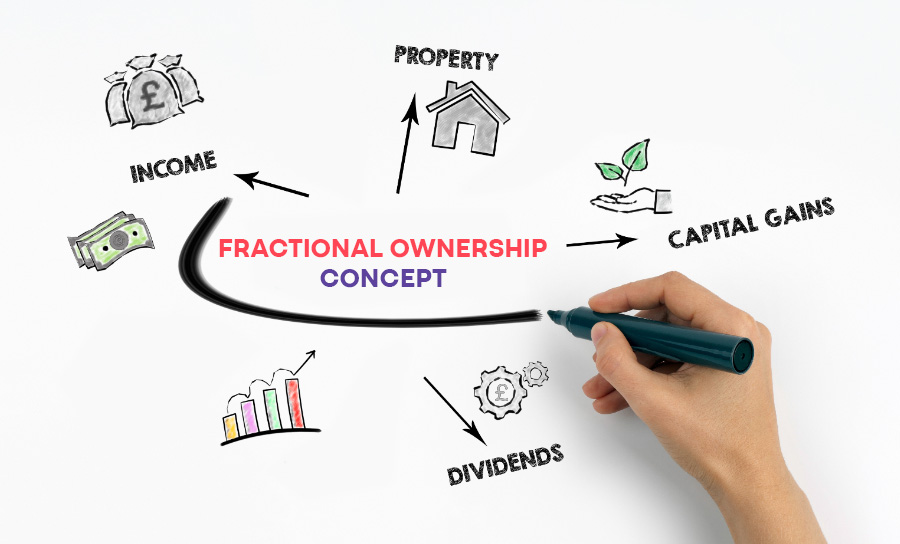
Are you ok with optional cookies ?
They let us give you a better experience, improve our products, and keep our costs down. We won't turn them on until you accept. Learn more in our cookie policy.

Fractional ownership in the realm of real estate investment is a relatively new but increasingly significant concept, particularly in the United Kingdom. This is particularly true because the home-buying process in the UK is not only complicated but also very expensive. Fractional ownership represents a shift from traditional notions of property ownership, introducing a model that is both innovative and accessible. In this write-up, we'll delve fractional ownership aims and concepts, analyse its impact on the UK real estate market, and explore notable case studies that showcase its benefits and successes.
Let’s start with the concepts of the fractional ownership model in the United Kingdom.

Definition: Fractional ownership in real estate refers to the sharing of a property among a group of individuals. Each owner holds a fraction of the property, entitling them to usage rights and a share of the income generated from the property, if any.
Structure: Typically, a management company oversees the property, ensuring maintenance, booking, and allocation among fractional owners. The owners pay a proportionate share of the property's upkeep costs.
This model enables a broader range of investors to access investment in high-value properties by splitting the cost among several parties.
Flexibility: Owners have the flexibility to use the property during allocated times or to earn income from rentals during their unused periods.
Some key points to consider are:
The UK's residential market dynamics present obstacles for potential homeowners since major cities' property prices constantly climb, leading to the emergence of fractional ownership as a strategic solution.
The approach offers a workable solution in a situation when housing demand exceeds supply by enabling people to access the market without having to shoulder the entire financial burden of property ownership.
Fractional ownership can be a sensible option for prospective investors limited by their finances.
With the help of the concept, anyone can enter the real estate market and gradually build portfolio of assets without having to make a sizable upfront financial commitment. They can invest small and grow it over time.
It offers a stepping stone towards the ultimate objective of becoming a homeowner, which is especially helpful in areas where there are few reasonably priced options and high property prices.
With fractional investing, investors can put themselves in highly sought-after urban locations, where there is a great chance of capital appreciation and property values are usually greater.
Investors can profit from rising property prices as they steadily lay the financial groundwork required to become homeowners in the future.
By balancing short-term rewards with long-term goals, this strategic positioning strengthens the overall investment strategy.
Fractional ownership presents itself as a two-fold financial instrument, acting as a planned approach to creating an alternate income source through rentals as well as a way to build an impressive property portfoliofor the long term
Investors aggressively position themselves within the changing UK real estate market in addition to practicing prudent financial planning.
Because of its dual function, property ownership becomes a dynamic, inclusive market in which investors with different levels of income can engage.

It enables more people to invest in properties that would otherwise be beyond their financial reach.
Investors can diversify their investment portfolio without committing a large amount of capital to a single property.
Professional management companies handle the management of fractional ownership, reducing the burden of property management for individual owners.
Fractional ownership in UK real estate emerges as a compelling choice for investors seeking effective retirement planning strategies. It not only provides an opportunity to grow wealth but also establishes an alternate source of income. Particularly attractive for seniors, this investment option boasts a rental income of 9-13 percent annually and an overall Internal Rates of Return (IRR) of 20 - 30 percent over the life of the asset, markedly exceeding the performance of many traditional retirement plans. This substantial edge offers investors a viable avenue to enhance their financial stability in retirement.
Because fractional ownership provides a steady stream of income each month, it presents itself as a great asset for retirement portfolios. A reliable income becomes essential after retirement, and fractional ownership offers a passive income stream in the form of rents that can be up to three times more than standard investment products.
The goal is to establish real estate fractional ownership as a reliable asset class. It provides portfolio diversification, monthly income (usually between 9 and 13 percent), and capital security as it remains locked in a tangible asset like property which is low risk. This consistency is especially important for retirees, who value steady earnings with less exposure to risk.
Emphasising the operational and liquidity advantages of fractional ownership is another goal. It is simple for investors to switch between different assets, and selling a fractional investment is a simple procedure as well. Investors can handle their finances more effectively because of this flexibility.
The 'Goldilocks', where the investment is neither unreasonably expensive nor restrictively little, is the goal of fractional ownership. Investors are able to customise their investing strategy by selecting the level of their involvement. This adaptability ensures that fractional ownership turns into a desirable and customised choice for investors.
Fractional ownership's cooperative structure attempts to ease investors concerns about property management. Investors approaching retirement age find investing in real estate less daunting and more accessible when they share duties and risks with other investors.
1. Market Expansion: Fractional ownership has expanded the real estate market, luring in new investors who were previously unable to afford it.
2. Innovation in Property Sales: It has introduced innovative sales and management models, often leveraging technology for efficiency and transparency.
3. Regulatory Environment: The UK's legal and regulatory framework continues to evolve to accommodate and regulate this new form of ownership.
Luxury Properties in London: The successful sale of several high-end properties in London under the fractional ownership model has attracted several international investors.
Holiday Homes: Coastal and countryside holiday homes in the UK have seen a rise in fractional ownership, offering a cost-effective way for many to own a holiday retreat.
Urban Development Projects: Some urban redevelopment projects have utilised fractional ownership to attract a diverse group of investors, fostering community involvement in regeneration efforts.
HMOs and PBSAs: In the context of student housing, particularly in the United Kingdom, House in Multiple Occupation (HMOs) and Purpose-Built Student Accommodation (PBSAs) represent two significant categories that are particularly relevant when discussing fractional ownership and its impact on the real estate market. These types of properties are often associated with high rental income potential, making them attractive investment opportunities within the fractional ownership model.
Let’s understand what HMOs and PBSAs are:
Definition: HMOs are properties rented out by at least three people who are not from one 'household' (e.g., a family) but share facilities like the bathroom and kitchen. They are common in university towns and cities.
Rental Income Potential: Due to the higher number of tenants, HMOs typically offer higher rental yields compared to traditional single-family rentals. This is particularly true in student-dominated areas where demand for such accommodations is high.
Fractional Ownership Impact: Fractional ownership in HMOs allows investors to enter the student housing market with lower initial capital. It diversifies risk and increases the pool of potential investors.
Regulatory Considerations: HMOs are subject to specific regulations, including licencing and standards, which can vary by local authorities in the UK.
Definition: PBSAs are housing units specifically designed and built for student residents. These accommodations range from studio apartments to shared flats and offer facilities tailored to student needs.
Growing Market: The PBSA sector has seen significant growth in the UK, driven by the increasing number of students and the demand for high-quality student housing.
Rental Income: PBSAs often command a premium in rental income due to their proximity to educational institutions, modern amenities, and tailored services for students.
Fractional Ownership Opportunities: Investing in PBSAs through fractional ownership can provide a steady income stream, given the consistent demand. Specialised companies typically manage these properties, making it a hands-off investment.
Synergy: The combination of HMOs and PBSAs with fractional ownership creates a synergy that enhances the accessibility of these investment opportunities. It allows smaller investors to participate in the lucrative student housing market.
Risk Mitigation: Fractional ownership in student housing diversifies risk among multiple investors, making it a more secure investment compared to individual ownership.
Market Dynamics: The student housing market, especially in university towns, remains robust, often showing resilience in economic downturns, which adds to the attractiveness of this investment.
Incorporating social housing into the fractional ownership model presents a unique opportunity to address the growing demand for affordable housing in the UK while providing stable rental income potential for investors. Social housing, typically aimed at providing affordable homes to those in need, often involves government bodies or councils as key stakeholders. By integrating this sector with fractional ownership, there is potential to accelerate the development and availability of social housing units.
Definition: Social housing is provided by local authorities to accommodate individuals and families with low incomes or particular needs. It typically subsidises the rent for families in need of social housing, and councils typically rents properties on longterm leases from landlords for giving them to families who are in need.
Demand and Shortage: There is a significant demand for social housing in the UK, with many on waiting lists due to a shortage of available units.
Stable Rental Income: Social housing often involves long-term leases with local councils or housing associations. These entities act as reliable tenants, reducing the risk of rental voids and ensuring a stable income for property owners.
Investment Appeal: For investors, the stability of rental income in social housing is a significant draw. The involvement of councils or housing associations as tenants often guarantees a steady return on investment with less volatility compared to the traditional private rental sector.
Risk Distribution: Fractional ownership distributes the risks associated with property investment among multiple owners, making it a safer option for individuals to invest in the social housing sector.
Community and Social Impact: Investing in social housing through fractional ownership not only yields financial returns but also contributes to a social cause—providing affordable homes for those in need.
Long-Term Leases with Councils: There are instances where investors have leased properties to councils for use as social housing on long-term contracts, ensuring a stable rental income.
Regeneration Projects: Some urban regeneration projects have included a social housing component, financed through various investment models, including fractional ownership.
The regulatory framework heavily regulates the social housing sector. Any fractional ownership scheme must navigate these regulations to ensure compliance.
Social Impact vs. Profit Motive: Balancing the social objectives of providing affordable housing with the profit motives of investors can be challenging. Transparent and ethical management are essential.
Investors in social housing should expect a long-term commitment because these properties typically have lower liquidity compared to other real estate investments.

Meet Sarah, a savvy investor who sought innovative opportunities with Novyy in the thriving realm of fractional ownership. Her investment journey delves into the lucrative world of social housing, showcasing the dynamic benefits of fractional ownership in the UK property market.
Novyy's unique approach to fractional ownership drew Sarah, a forward-thinking investor. With a desire to diversify her portfolio and make a social impact, Sarah opted to invest in a shared ownership model that focuses on social housing.
Through Novyy’s platform, Sarah gained access to a carefully curated portfolio of social housing properties. The transparent and user-friendly interface allowed her to browse, analyse, and select a property aligned with her investment goals and values.
Sarah, along with other fractional owners, collectively invested in the property, spreading the financial commitment and minimising individual risk. Novyy’s expert team facilitated a seamless investment process, ensuring legal and financial considerations were meticulously addressed.
Novyy’s commitment to property management excellence shone through. The team handled tenant selection, property maintenance, and regulatory compliance with precision. Sarah appreciated the hassle-free experience, allowing her to enjoy the financial benefits without the day-to-day operational burdens.
Beyond financial gains, Sarah found fulfilment in contributing to social housing initiatives. Novyy’s focus on creating positive societal change resonated with her values, making the investment not just a financial decision but a meaningful contribution to the community.
Novyy’s commitment to transparency extended to regular updates and open communication. Sarah remained informed about property performance, rental yields, and any relevant market insights, fostering a sense of trust and partnership.
Therefore, Sarah's success with Novyy.com's fractional ownership model in social housing exemplifies the versatility and impact of this investment approach. Whether in social housing, holiday lets, or other sectors, fractional ownership through Novyy.com offers a pathway for investors to diversify their portfolios, make a positive societal impact, and benefit from professional property management expertise.
Fractional ownership is reshaping the landscape of property ownership in the UK, offering a viable alternative to traditional real estate investment methods. Its ability to democratise access to luxury properties and provide investment opportunities to a wider audience makes it a significant factor in the future of the real estate market. However, the full potential of this model will depend on regulatory adaptations and market acceptance as it continues to evolve. In the case of HMOs and PBSAs, they represent a significant segment of the student housing market with high rental income potential. Their integration with fractional ownership models presents an innovative investment opportunity, allowing a more diverse group of investors to benefit from the consistently high demand for student accommodation. As this sector continues to grow, it is likely to attract further attention from both domestic and international investors, particularly those seeking steady income streams and diversification in their real estate portfolios. Extending fractional ownership to the social housing sector in the UK presents a promising avenue to address the housing shortage while offering investors a stable and potentially socially responsible investment. By pooling resources and distributing risk, this approach can accelerate the development of much-needed affordable homes. For councils and housing associations, partnering with fractional investors can be a viable strategy to expand their housing stock. This model, however, requires careful consideration of regulatory frameworks and a balanced approach to aligning social impact with financial returns.